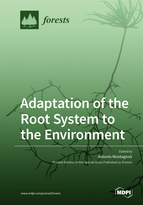Adaptation of the Root System to the Environment
A special issue of Forests (ISSN 1999-4907). This special issue belongs to the section "Forest Ecophysiology and Biology".
Deadline for manuscript submissions: closed (20 July 2021) | Viewed by 24214
Special Issue Editor
Interests: root development; plant morpho-physiology; afforestation; fire; biochar
Special Issues, Collections and Topics in MDPI journals
Special Issue Information
Dear Colleagues,
Plant roots have a fundamental role in water and nutrient uptake while ensuring plant anchorage and stability. Root systems fulfil these functions responding to alterations in environmental conditions through a series of changes at the morphological, physiological, and molecular levels. In response to external disturbances, the finest fraction of the root system modifies traits such as length, the diameter of the root population, specific root length, and life span, whereas the coarse root fraction is spatially displaced to accomplish the highest plant anchorage. Further, wood production in coarse roots is laid down asymmetrically, resulting in an eccentric pattern.
Changes in rooting environment can be ascribed to natural conditions (seasonality of resource availability, sloppy terrain, and prevailing high wind) as well as to the human-induced activities (logging, fire, etc.).
This Special Issue aims to unveil, at all levels of investigation (seedling, singletree, and community level, from morphology to molecular), plant response to environmental clues that may trigger root adaptation mechanisms.
Innovative research is needed to improve our knowledge on forest ecophysiology and biology; new technologies for root investigation will also benevolently considered.
Therefore, we are soliciting full research papers and short communications presenting new findings that will bring advances in forest root research. Due to the high biological variability across tree species and ecosystems, case studies will also be considered for publication.
Dr. Antonio Montagnoli
Guest Editor
Manuscript Submission Information
Manuscripts should be submitted online at www.mdpi.com by registering and logging in to this website. Once you are registered, click here to go to the submission form. Manuscripts can be submitted until the deadline. All submissions that pass pre-check are peer-reviewed. Accepted papers will be published continuously in the journal (as soon as accepted) and will be listed together on the special issue website. Research articles, review articles as well as short communications are invited. For planned papers, a title and short abstract (about 100 words) can be sent to the Editorial Office for announcement on this website.
Submitted manuscripts should not have been published previously, nor be under consideration for publication elsewhere (except conference proceedings papers). All manuscripts are thoroughly refereed through a single-blind peer-review process. A guide for authors and other relevant information for submission of manuscripts is available on the Instructions for Authors page. Forests is an international peer-reviewed open access monthly journal published by MDPI.
Please visit the Instructions for Authors page before submitting a manuscript. The Article Processing Charge (APC) for publication in this open access journal is 2600 CHF (Swiss Francs). Submitted papers should be well formatted and use good English. Authors may use MDPI's English editing service prior to publication or during author revisions.
Keywords
- Fine roots
- Coarse roots
- Drought
- Fire
- Forest management
- Disturbance
- Morphology
- Physiology
- Molecular biology






